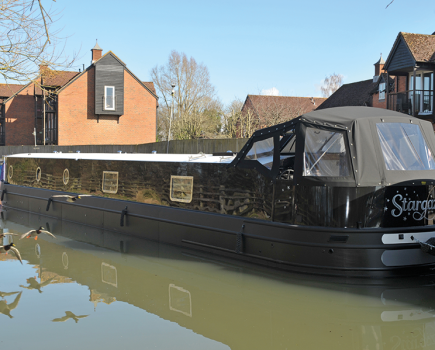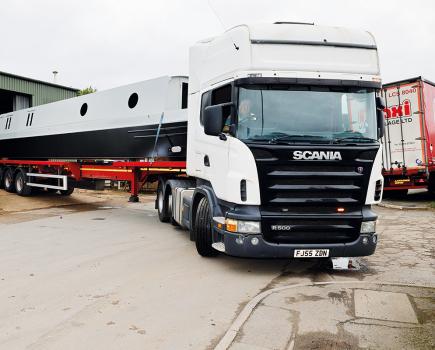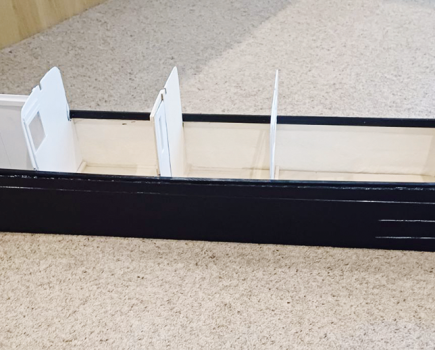Boating Leisure Services are back in the winners’ enclosure with an elegant craft full of future-proofed features

Boating Leisure Services are the holders of a Crick Boat Show record, as the only builder to win the Favourite Boat vote three years in a row, between 2014 and 2016. Then last year, because of the timing of the boats in build, they didn’t show a boat at all. But this year they were back —and in some style.
Armstrong (all their spec boats have been named after explorers — and Neil Armstrong was an explorer of sorts) is perhaps a more straightforward boat than some we’ve seen from BLS, but it’s no worse for it. It certainly appealed to visitors to the Crick Show, because they voted it into third place in the Favourite Boat contest. That means that in the past six years, the firm has shown five boats, and all of them have been placed.
As well as building boats, Boating Leisure Services does a lot of servicing and repairs, so there’s a wealth of experience about what works, what goes wrong, and what probably shouldn’t have been tried in the first place. The BLS team has used all that knowledge to build a boat that’s stylish, has bullet-proof equipment on board, and should be trouble-free. That said, there is one genuinely new piece of kit that’s been installed: the latest Vetus bow thruster, a brushless version, which offers real advantages over previous ones.

Exterior
Armstrong is based on a 60ft semi-trad shell by Tyler Wilson (and it’s perhaps worth noting that all three of the boats in the top three at the Crick Show were built on their shells). It has one of Tim Tyler’s standard bows, which just goes to prove that if you want a pretty boat you don’t have to specify a Josher. It undoubtedly helps that the well deck and nose are a generous nine and a half feet long, giving the boat a look that’s both elegant and imposing. It has real presence on the water. As you might expect from such a well known shell builder, all the steelwork looks good, and there are some nice touches such as the plank effect on the stern counter, and scrolls in the cants and handrails.
There are plenty of traditional features on the outside of the boat. The colour scheme is a classic black and grey with cream coachlines, and red used for the name panel and the handrails. The roof is painted raddle red, and so are the gunwale tops — a choice which adds to the traditional feel of the boat. So does the use of scumbling on the roof aft of the boatman’s beam. The paintwork was done by the in-house painter at BLS’s base at Heyford Fields, Mike Looby, while the lettering and scumbling was by the well respected Dave Moore.
The mushroom vents and other deck fittings are brass, to emphasise the traditional look. The portholes match, but they also make use of modern technology as they’re double glazed; the whole glass opens, too. The side doors each side of the boat are positioned roughly where they would be if this boat had an engine room; it doesn’t — the doors are actually in the galley — but it’s another way this boat fools you into thinking it’s really traditional.

The gas locker is in the nose, and will take two full size bottles. The well deck is generously sized and has a locker running across it. This offers both storage, and access to the bow thruster. Under the well deck is a stainless steel water tank.
At the stern, the semi-trad deck has lockers both sides, so there’s plenty of space to store mooring stakes and such like. The lockers are scalloped so the rear doors can open fully and won’t get in the way of the crew.
Layout and fitout

This is a reverse layout boat, which has the galley at the stern, incorporating a breakfast bar. The saloon is open plan to the galley, in the centre of the boat, followed by a walk-through shower room. The cabin is at the bow.
The fitout uses oak for the furniture, the bulkheads, and the panels below the gunwales. There’s some nice joinery on show throughout. The cabin sides use a tongue and groove effect, which continues on the painted ceiling — and we really liked the way the grooves match all the way up and over. It’s the sort of attention to detail that makes a boat stand out. The flooding is a Luxury Vinyl Tile in a walnut effect in the galley and saloon, and stone effect in the shower room. The cabin has carpet.
Galley

We’ll start our tour at the stern, where three steps bring you down into the boat from the stern deck. The tread of the middle step lifts for storage, while the bottom one contains a drawer. There are cupboards either side, almost dresser style, with deeper units at the bottom and shallower ones at the top. On one side the cupboard is heated to help dry coats and boots; on the other side is the electrical cupboard, which also contains a range of gauges which are illuminated in blue.
Immediately inside the boat is the breakfast bar, made with a black granite worktop. There are a couple of stools, and a cupboard underneath (in what would otherwise have been a dead corner) houses a Candy washing machine.
The galley proper is U-shaped, which means the person cooking or washing up doesn’t get in the way of anyone else who wants to walk through. Beneath the granite, the cupboard doors are painted a putty colour. One hides a full size, 240 volt Capel fridge. Opposite is a full size gas oven, with a four-burner hob above, both also by Capel. It’s a brand BLS has used before, and knows works well. There’s a stainless steel sink, and a smart tap whose angle just happens to perfectly match the tumblehome of the cabin sides. There are a couple of high-level units, which have lights underneath, turned on simply by touching them.

Saloon
A half-height bulkhead separates the galley and the saloon; on the saloon side there’s a little cubby hole, complete with another touch-light inside. The room is mostly left clear for free-standing furniture (the chairs in place during the show and our test were borrowed from Elite Furnishings).
But there are a couple of pieces of built in furniture. One is a tv unit which has all the power sockets you need inside, as well as cabling for a satellite system — a thoughtful addition as it would be difficult to retrofit. There’s a cable tidy through the top of the unit to keep everything neat.
The other is a unit which surrounds the stove. There are cupboards either side of the hearth, and mirrors and glass shelves above. The stove itself is a Hamlet Hardy; the flue, which is buried in the unit, is double insulated, and there’s extra insulation built in too. The hearth is constructed with an air gap, and there’s a lip to catch anything which falls out of the stove.

As well as plentiful ceiling lights, there’s also lighting under the gunwales.
Shower room
This is a generous space with a sense of luxury. The shower itself is a good size, with an 800 by 900 mm quadrant. It’s lined with laminate, with a subtle but rather funky design. There are a few shelves between the shower and the hull sides.

A large white oval basin sits on a granite-topped vanity unit, with cupboards underneath and a mirror above. There’s a towel rail too. The loo is a Lee Sanitation macerating unit, with the holding tank immediately behind, under the bed. That means the length of pipe between the two is commendably short.
Cabin
The bed is in-line, and pulls out to a full 5ft width. It also lifts up on gas struts so the storage underneath is easily accessible. The loo tank takes up some of the space, but there’s still a good amount of room, and the whole area is nicely lined, so you’d feel very comfortable storing things down there.
Furniture consists of a chest of drawers fitted with soft closures, and a large wardrobe. There’s also a small unit on the opposite side of the bow doors, and a couple of high level cupboards above the head of the bed. The reading lights fitted underneath will dim if you touch and hold the switch.
Technical
Armstrong is powered by a Beta 43 teamed with a PRM 150 gearbox. This is a ubiquitous combination, which is proven to be reliable and every boat yard in the country will be familiar with.
The bow thruster is interesting, because it’s the latest brushless model from Vetus. It has a number of advantages over a normal electric bow thruster. One is that it can be run for much longer than the five or ten second bursts a standard unit is limited to. Another is that it’s proportional — so while a normal thruster is either on or off, this one can be asked to give you a little bit of help or a lot. It’s controlled by a joystick, so if you push it just a little way over you get a little bit of thrust, but push it further and you get more. This unit is rated at 65kgf, which sounds as though it might be a bit feeble; normally a boat this size would have a 75 or even 95kgf thruster. But because you can use it for much longer, you can make better use of the available power. Indeed, if you need to use the thruster for a long time, perhaps when winding in the middle of a marina, you can set it going and press a button on top of the joystick to keep it turned on. Of course another plus is that being brushless means there aren’t brushes to wear out.
Electrical power comes from six 130Ah domestic batteries, but this is a 24 volt boat so the total bank is 390Ah. BLS fits a 24 volt system as standard, believing it has advantages over the more usual 12 volts. It’s more stable, there’s a lower draw, and there’s less voltage drop. But some things, like the engine starter motor for example, need a 12 volt supply, so there’s a separate charger for that battery. A 240 volt supply comes from a 3kw Victron combi inverter charger. The boat doesn’t currently have solar panels but the wiring is in place so adding them would be straightforward. It’s another example of this boat being future-proofed for its new owners.
Boating Leisure Services are experts in Eberspacher boilers, so it’s no surprise that this boat has one for heating and hot water. The calorifier is in the engine hole.
On the water
We’ve always liked the handling of Tyler Wilson shells, and this one is no exception. It responds well to the tiller, goes exactly where it’s pointed, and turns extremely well. Push the tiller over and apply a bit of power, and the bow moves over straight away. We also ended up going a fair distance backwards during our test (because of the need for photos) and the boat coped remarkably well with that too; here the bow thruster came in useful for little corrections in direction. And when needing to spin round in the marina, the thruster showed that it’s plenty powerful enough; with the right combination of engine power, tiller direction, and bow thruster, you can pretty much turn on a sixpence. It’s in a situation like this that the ability to leave the bow thruster going without having your finger on the control comes in useful.
At the helm, the Morse control, on a column, falls easily to hand, as do the clearly marked switches for things like the tunnel light and nav lights. The bow thruster’s joystick is positioned on top of the column, where it’s easy to use — but I did wonder if it might be slightly vulnerable to being accidentally knocked and damaged.
The stern deck has plenty of room for crew, and the lockers give them somewhere to sit. The engine is quiet, so conversations are easy to hear.
Conclusion
This is a very stylish boat, which nails that combination of a traditional look on the outside with a contemporary layout and style inside. The workmanship is top notch, both in the joinery and the engineering, where Boating Leisure’s experience from their repair business means they know how to get installations right. Plus it all comes on a top quality shell with fantastic lines and excellent handling.
This boat was for sale at the show at £135,000 — which is a good price for a boat of this quality. It has everything you need, without loading in gimmicks and unnecessary gadgets. All the equipment on board is tried and tested, and chosen for reliability.
With a boat of this quality and appeal, it’s not surprising people voted for it. To have produced yet another boat that’s made it onto the Crick podium indicates that Boating Leisure Services really are doing things right.
Boating leisure services
Dave Flowers and Gary Manning founded Boating Leisure Services back in 1998 as a boat maintenance business, and have been based at the workshop at Heyford Fields Marina on the Grand Union since 2010.
The move into boat building happened by a rather unusual route. In 2012, the owners of the marina decided to build a boat to sell. They employed a joiner to fit it out, while Dave and Gary did all the engineering. Eventually the boat building was moved into BLS. Armstrong is the firm’s ninth boat; they include two completed for the owners when the original builders closed down, and last year they also fitted out a couple of widebeams.
It’s a very busy firm, employing a handful of other staff on both the boat building side and on maintenance — Dave in particular can often be found going out to fix break downs, and he’s also an acknowledged expert in Eberspacher diesel boilers. There’s a constant stream of boats in for blacking and other work.
Technical specification
Heyford Fields Marina, Bugbrooke Road, Nether Heyford, Northants. NN7 3NP
01604 833599. 07979 746156
www.boatingleisureservices.com
bls@boatingleisureservices.com
Length: 60ft
Beam: 6ft 10in
Shell: Tyler Wilson
Style: Semi-trad
Layout: Standard
Berths: 2
Fit-out: Oak
Engine: Beta 43 Tel: 01452 723492 www.betamarine.co.uk
Inverter: Victron 3kw www.victronenergy.com
Bow Thruster: Vetus 65kgf brushless www.vetus.com
Galley tap: Abode Linear Flair www.abodedesigns.co.uk £140
Stove: Hamlet Hardy www.aradastoves.com £340
Touch lights: Lumo LED 9 Warm www.midlandchandlers.co.uk 19.90 each
Total Price: £135,000
Image(s) provided by:
Archant







